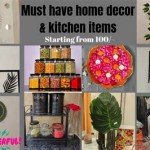How to Start Your Own Home Decor Business
Starting a home decor business can be a rewarding venture, allowing you to combine your creativity with a passion for beautiful spaces. However, it's crucial to approach this endeavor with a well-defined plan and a commitment to building a successful brand. This article will outline the key steps involved in launching your own home decor business, from conceptualization to marketing and beyond, providing a comprehensive guide to navigate this exciting journey.
1. Defining Your Niche and Brand Identity
Before diving into the logistics of starting your business, it's essential to establish a clear vision for your brand. Defining your niche and crafting a compelling brand identity will guide your decisions and ensure your products resonate with your target audience.
Identify Your Niche: What type of home decor will you specialize in? Consider factors like your personal style, market demand, and potential competition. Are you drawn to handcrafted items, vintage finds, minimalist designs, or bold, eclectic pieces? By focusing on a particular niche, you can establish yourself as an expert within the market and attract a loyal customer base.
Develop a Brand Identity: Your brand identity encompasses your brand name, logo, color palette, and overall aesthetic. It should reflect your niche and the values you stand for. Ensure your brand name is memorable, relevant, and available for registration. A visually captivating logo communicates your brand's essence, while a consistent colour palette creates a sense of unity across your marketing materials.
Craft a Brand Story: A compelling brand story connects with your audience on an emotional level. It shares your passion for home decor, your design philosophy, and the unique story behind your brand. This personal touch establishes credibility and helps you stand out from the competition.
2. Business Planning and Legal Requirements
Once you have a firm grasp of your brand identity, it's time to create a comprehensive business plan. This document will serve as your roadmap, outlining your business goals, strategies, and financial projections.
Business Plan Essentials:
- Executive Summary: A concise overview of your business, its mission, and key objectives.
- Market Analysis: Research your target market, analyze competitors, and identify opportunities and threats.
- Products and Services: Detail your product offerings, their pricing, and their unique value propositions.
- Marketing and Sales Strategy: Outline your plans for reaching your target audience and driving sales.
- Financial Projections: Present your projected income, expenses, and profit margins.
Legal Requirements: Depending on your location, establishing a home decor business may require specific legal steps.
- Business Registration: Registering your business as a sole proprietorship, partnership, LLC, or corporation ensures legal protection and proper taxation.
- Tax ID Number: Obtain an Employer Identification Number (EIN) from the IRS for tax purposes.
- Business Licenses and Permits: Investigate local licensing and permitting requirements, such as business registration and sales tax permits.
- Insurance: Consider liability insurance to protect your business from potential risks.
3. Sourcing and Production
The next step is to determine how you will source and produce your home decor products.
Sourcing Options:
- Wholesale Suppliers: Partner with wholesalers offering a variety of home decor items at discounted prices.
- Direct Manufacturers: Work directly with manufacturers to customize products or create unique pieces tailored to your brand.
- Handmade Products: If you have crafting skills, consider creating your own home decor items. This allows for greater control over quality and design.
Production Process: Once you've chosen your sourcing method, establish an efficient production process.
- Inventory Management: Develop a system for tracking inventory levels, placing orders, and managing stock.
- Quality Control: Implement strict quality control measures to ensure your products meet your standards.
- Packaging and Shipping: Decide on packaging materials and shipping methods that are both practical and aesthetically pleasing.
4. Marketing and Sales Strategies
To reach your target audience and generate sales, you need a strong marketing strategy.
Online Marketing:
- Website: Create a professional website showcasing your products, brand story, and contact information.
- E-commerce: Set up an online store to sell your products directly to customers.
- Social Media: Engage with your target audience on platforms like Instagram, Pinterest, and Facebook.
- Search Engine Optimization (SEO): Optimize your website and online content to rank higher in search engine results.
- Paid Advertising: Utilize targeted advertising campaigns to reach a wider audience.
Offline Marketing:
- Trade Shows and Events: Showcase your products at industry trade shows and local events.
- Collaborations: Partner with other businesses or influencers to expand your reach.
- Public Relations: Seek media coverage in publications or blogs relevant to your niche.
- Local Partnerships: Collaborate with local businesses or events to promote your products.
5. Customer Service and Operations
Delivering exceptional customer service is paramount for any business, especially one focused on aesthetics and personal style.
Responsive Communication: Respond promptly to customer inquiries, orders, and feedback.
Personalized Service: Offer personalized recommendations and advice to ensure a positive customer experience.
Return and Exchange Policies: Establish fair and transparent return and exchange policies to build trust.
Operations and Inventory Management:
- Order Fulfillment: Implement a streamlined order fulfillment process for efficient delivery.
- Inventory Tracking: Maintain accurate inventory records to prevent stockouts and overstocking.
- Financial Management: Track your income, expenses, and cash flow to ensure financial stability.
6. Continuous Improvement and Growth
The home decor business is dynamic and constantly evolving. To stay competitive, it's essential to embrace continuous improvement and growth strategies.
Stay Updated on Trends: Keep abreast of emerging home decor trends, materials, and styles.
Seek Feedback: Regularly solicit customer feedback to understand their preferences and make improvements.
Expand Your Offerings: Introduce new product lines or services to diversify your offerings and cater to a broader market.
Embrace Technology: Utilize technology tools to streamline operations, enhance customer service, and analyze data for better decision-making.

How To Start A Home Decor Business Complete Guide

How To Start An Interior Design Business The Complete Guide 2025

5 Ideas For A Home Decor Business Talk

How To Start An Interior Design Business The Complete Guide 2025

How To Start An Interior Design Business The Complete Guide 2025

9 Steps To Launch Your Own Diy Home Decor Box Business

The Cost To Start Your Own Interior Design Business School By Alycia Wicker

How To Start A Home Decor Business Complete Guide

How To Launch A Home Decor Business Using Desygner Step By Guide Designing Your Own With Is The Perfect Way Take

How To Start Your Own Business Creating An Home Garden







